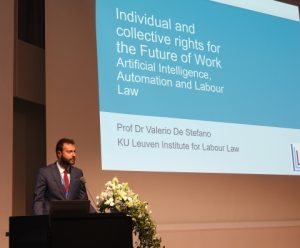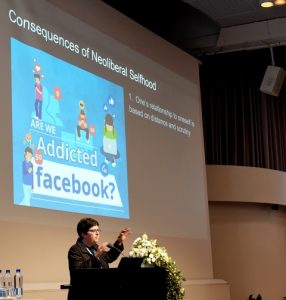The second day of the conference featured presentations on work automation and its links to employees’ rights and privacy.
The second day of the WORK2019 conference featured keynote presentations on work automation and standardisation, as well as personal branding. During the day, digital visibility and invisibility in work were also discussed.
Digitalisation has enabled a new kind of transparency in working life. Various organisational applications, such as Slack and Yammer, allow messages to be sent among the entire work community. With collaborative tools like Google Drive, people can learn from each other when they see what kind of process is necessary for writing a certain type of document, for example.
The transparency brought about by digitalisation has greatly helped develop the work done in many industries. For example, in the healthcare and nursing sector, the ability to save and retrieve vast masses of data has made work more efficient.
At the same time, several technologies hide things from view. LinkedIn lets us see that an acquaintance got promoted, but we do not see the work that was required to get the promotion. The operation of various artificial intelligence often remains a mystery to those unversed in the subject. Discussions on things such as privacy have also intensified in recent years.
Work automation does not mean more autonomy
Thursday featured three keynote speeches, the first of which was delivered by Professor of Labour Law Valerio De Stefano from KU Leuven. De Stefano’s keynote was titled Individual and collective rights for the Future of Work: Artificial intelligence, Automation and Labour Law.

The impact of new technologies on work and the future of work are recurring subjects of public debate. According to de Stefano, however, the debate has revolved too much around how many jobs will be lost due through technological innovations. In his speech, he focused on how the quality of jobs will develop in the labour market in the future.
There is great concern about robots taking people’s jobs, but various software and artificial intelligence is already being used for managing and monitoring the workforce. For instance, the people working in Amazon’s warehouses wear IoT wristbands to which instructions and directions are sent. The wristband keeps track of how many products the employee collects from the warehouse during the working day and how quickly. All the information from the wristband is sent to Amazon.
“Automation doesn’t necessarily mean more autonomy,” De Stefano pointed out.
Although employment regulation is often thought to protect employees, De Stefano believes it gives the employer an unfair position of power in relation to the employee. Employers have the power to assign and change the tasks or physical work locations of their employees, to monitor their work digitally and to discipline them. Employees also often accept these unspoken practices.
In his speech, De Stefano remarked that the central role of artificial intelligence and automation in the work of the future will mean that collective labour rights are required. This means not only ensuring the quality of basic working conditions, but also protecting the dignity of workers as well as rationalising management and if necessary, countering it. The challenges posed by artificial intelligence and automation can only be met through cooperation.
De Stefano called for a humans-in-command approach to work.
“You cannot let a machine have the last word. You should always have a human in charge of the decisions,” De Stefano cautioned.
Connective labour may become the luxury of the few in the future
The second keynote speaker of the day was Professor of Sociology Allison Pugh from the University of Virginia, whose topic was The Future of Interpersonal Work: Inequality, Insecurity and Automation in Connective Labor.
In her speech, Pugh spoke about so-called connective labour and how it is transformed through digitalisation. By connective labour, Pugh means labour that depends on the ability of employees to maintain relationships with other people. This kind of labour is included in many of today’s professions, such as teaching or nursing. It is often of great importance for the well-being of the patient or the client.

Efforts are increasingly being made to increase the productivity of connective labour. Therefore, virtual-assisted tools have been introduced in many fields to systematise service. You may need to talk with a virtual nurse before you get to see a doctor and you can now get therapy, for instance, simply through a smartphone app. According to Pugh, this kind of systematisation is based on presumptions that complex relationships can be reduced to simple emotions.
The danger is that the virtual standardisation of services will lead to inequality, because face-to-face interaction may not necessarily be offered to everyone. Automatised connective service is often provided to people in a disadvantaged position, such as the disabled and those with low incomes. However, they are the ones most in need of human contact.
“The automatisation of connective labour can make people feel more unseen”, Pugh remarked.
According to Pugh, there is also a strong belief that a virtual version of connective labour is better than nothing. If a low-income family in the United States cannot afford to send their child to preschool, it is better to at least get teaching in a digital format.
“Connective labour may become the luxury of the few.”
Personal branding makes the employee into a company
Thursday’s final keynote was delivered by Professor of Anthropology Ilana Gershon from Indiana University. Her speech was titled Me™: The Neoliberal Self at Work. The keynote delved into the branding of the individual in working life.
In her speech, Gershon shed light on Foucault’s ideas from the late 1970s, when the philosopher foresaw the rise of a new kind of shared vision: neoliberalism. According to the vision, in a world dictated by markets, people would succeed best as entrepreneurial selves.
According to Gershon, the neoliberal self presents itself today in the form of personal branding. People market themselves as bundles made up of skills, assets, experiences, qualities and alliances, as “companies” that they constantly manage and improve. Gershon believes the neoliberal selfhood is based on scrutiny and self-control, as one constantly strives to present the best version of themselves to the outside world.
The emphasis on neoliberal selfhood in working life leaves no room for traditional social cohesion. Relationships with others are framed in terms of instrumentality and utility: Who can take me forward in my career, who cannot?
“Relationships are instrumental and subject to market logic,” Gershon stated.
Employment relationships are also seen as temporary contracts that help people get to the next level in working life. Long-term employment relationships are becoming more uncommon and employers are hiring passionate individuals to carry out individual projects. When laying someone off is easy and normal, employees also begin to see work as temporary and easily resign.
Gershon believes good neoliberalist leaders understand this and help their employees gain the skills they need for the future during their employment.
“And so employees get forward in their careers, so they can become job quitters.”
However, the bleak picture of working life painted by neoliberalism is not the only option. You can also get off the ride.
“Some people are developing alternatives and don’t act according to neoliberalism. The technologies we use encourage us to think in a certain way, but we can use them differently.”

Text: Kira Keini / Kaskas Media
Images: Eija Vuorio, WORK2019 organising committee
The WORK2019 conference is an international forum held between 14.–16.8.2019, where research knowledge and experiences about work are exchanged among researchers and experts in work and the fields of working life. The conference is organised by the University of Turku together with the Turku Centre for Labour Studies TCLS, the SWiPE consortium funded by the Strategic Research Council at the Academy of Finland, and the Finnish Institute of Occupational Health.


